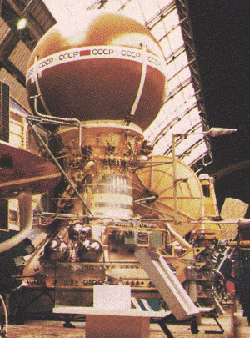Venera program
Venera program

The Venera 11 lander. (Credit: Soviet Space Program)

The Venera 13 orbiter. (Credit: Soviet Space Program)
The Venera series of satellites were launched by the Soviet Union to study Venus and its environment. Ten probes successfully landed on Venus and transmitted data from the surface. Thirteen probes successfully transmited data from the atmosphere of Venus. Four of the satellites carried gamma-ray burst detectors to help triangulate the position of observed bursts.
Lifetime: February 1961 (first attempted launch, Venara 1VA) - July 1984 (last contact with final Venera probe, Venera 16)
Country (primary): Soviet Union
Links to more information
Venera 11 and 12
Lifetime: September 1978 - February 1980 (Venera 11), April 1980 (Venera 12)
Primary Science
Venera 11 and 12 were identical spacecraft where were designed to study Venus and the interplanetary medium. Each spacecraft consisted of a flight platform and a lander probe. The flight platform carried instruments to study the solar-wind composition, gamma-ray bursts, ultraviolet radiation, and electron density of the ionosphere of Venus.
High Energy Science
Venera 11 and 12 each carried gamma-ray burst detectors.
Science Highlights
- Catalog of gamma-ray bursts which showed that each burst relases about 1040 to 1041 ergs of energy
Venera 13 and 14
Lifetime: October 1981 - March 1983 (Venera 13); November 1981 - March 1983 (Venera 14)
Primary Science
Venera 13 and 14 were identical spacecraft where were designed to study Venus and the interplanetary medium. Each spacecraft consisted of a bus and a descent craft. The bus relayed data for the lander and then continued into a heliocentric oribt.
High Energy Science
Venera 13 and 14 each carried gamma-ray burst detectors.
Science Highlights
- Confirmed gamma-ray bursts occurred one out of every three days
- Detected a total of 44, mostly confirmed, cosmic gamma-ray events

